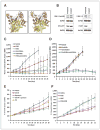Integrated next-generation sequencing and avatar mouse models for personalized cancer treatment
- PMID: 24634382
- PMCID: PMC4322867
- DOI: 10.1158/1078-0432.CCR-13-3047
Integrated next-generation sequencing and avatar mouse models for personalized cancer treatment
Abstract
Background: Current technology permits an unbiased massive analysis of somatic genetic alterations from tumor DNA as well as the generation of individualized mouse xenografts (Avatar models). This work aimed to evaluate our experience integrating these two strategies to personalize the treatment of patients with cancer.
Methods: We performed whole-exome sequencing analysis of 25 patients with advanced solid tumors to identify putatively actionable tumor-specific genomic alterations. Avatar models were used as an in vivo platform to test proposed treatment strategies.
Results: Successful exome sequencing analyses have been obtained for 23 patients. Tumor-specific mutations and copy-number variations were identified. All samples profiled contained relevant genomic alterations. Tumor was implanted to create an Avatar model from 14 patients and 10 succeeded. Occasionally, actionable alterations such as mutations in NF1, PI3KA, and DDR2 failed to provide any benefit when a targeted drug was tested in the Avatar and, accordingly, treatment of the patients with these drugs was not effective. To date, 13 patients have received a personalized treatment and 6 achieved durable partial remissions. Prior testing of candidate treatments in Avatar models correlated with clinical response and helped to select empirical treatments in some patients with no actionable mutations.
Conclusion: The use of full genomic analysis for cancer care is encouraging but presents important challenges that will need to be solved for broad clinical application. Avatar models are a promising investigational platform for therapeutic decision making. While limitations still exist, this strategy should be further tested.
©2014 AACR.
Conflict of interest statement
L.A. Diaz is an officer and board member for and has ownership interest (including patents) in Personal Genome Diagnostics; has received speakers bureau honoraria from Illumina; and is a consultant/advisory board member for Amgen. V.E. Velculescu is employed on the board of directors of, is CSO for, and has ownership interest (including patents) in Personal Genome Diagnostics. D. Sidransky is a chairman of, has ownership interest (including patents) in, and is a consultant/advisory board member for Champions Oncology. M. Hidalgo has ownership interest (including patents) in Champions Oncology. No potential conflicts of interest were disclosed by the other authors.
Figures


References
-
- Hanahan D, Weinberg RA. Hallmarks of cancer: the next generation. Cell. 2011;144:646–74. - PubMed
-
- Corless CL. Medicine. Personalized cancer diagnostics. Science. 2011;334:1217–8. - PubMed
-
- Baker M. Functional genomics: the changes that count. Nature. 2012;482:257. - PubMed
-
- Stratton MR. Exploring the genomes of cancer cells: progress and promise. Science. 2011;331:1553–8. - PubMed
MeSH terms
Substances
Grants and funding
LinkOut - more resources
Full Text Sources
Other Literature Sources
Research Materials
Miscellaneous

